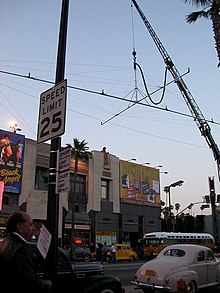Practical effect


A practical effect is a special effect produced physically, without computer-generated imagery or other post-production techniques. In some contexts, "special effect" is used as a synonym of "practical effect", in contrast to "visual effects" which are created in post-production through photographic manipulation or computer generation.[1]
Many of the staples of action movies are practical effects. Gunfire, bullet wounds, rain, wind, fire, and explosions can all be produced on a movie set by someone skilled in practical effects. Non-human characters and creatures produced with make-up, prosthetics, masks, and puppets—in contrast to computer-generated images—are also examples of practical effects.
Practical effect techniques
- The use of prosthetic makeup, animatronics, puppetry, or creature suits to create the appearance of living creatures.
- Miniature effects, which is the use of scale models which are photographed in a way that they appear full sized.
- Mechanical effects, such as aerial rigging to simulate flight, stage mounted gimbals to make the ground move, or other mechanical devices to physically manipulate the environment.
- Pyrotechnics for the appearance of fire and explosions.
- Weather effects such as sprinkler systems to create rain, fog machines to create smoke, and fake snow.
- Squibs to create the illusion of gunshot wounds.
See also
References
- ^ "What Are 'Practical Effects'?". www.merriam-webster.com. Retrieved 2023-04-21.
